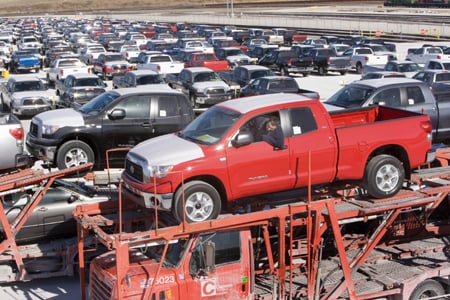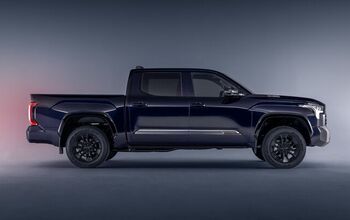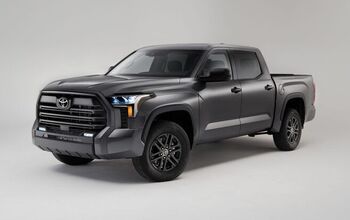The Curse of the Toyota Tundra
In a speech in Cape Town, South Africa, Robert F. Kennedy put a phrase into common usage by declaring "There is a Chinese curse which says, ‘May you live in interesting times.’" Lexicographers now say Kennedy made it up. But if it was true, you could argue that Toyota’s been cursed. While critics focus on the automaker’s recent experiences with recalls, leaked memos, NASCAR additives and misleading ads, pickup trucks are where things are starting to get scary.
Toyota’s new Tundra has been giving the automaker a rare case of the heebie-jeebies. Beancounters budgeted building the brand’s spanking new San Antonio truck plant at $850m. Due to last-minute changes and higher than expected material costs, the final tab ballooned to $1.28b. The executive who oversaw the cost overruns at the Tundra assembly plant, Hidehiko "T.J." Tajima, returned to Japan to assume Toyota's corporate social responsibility activities.
More worryingly (at least for a company as immensely profitable as Toyota), the San Antonio truck plant’s production schedule wasn’t in synch with their engine plant in Huntsville, Alabama. At the insistence of Toyota’s sales and marketing soothsayers, the first new Tundras to pop out of the cattle chute were supposed to contain 5.7-liter V-8 engines (so that the company could boast horsepower ratings that meet or beat the domestics’). But the big engine's production wasn't scheduled until mid-year.
For a company know for being as efficient as the Borg, this must have come as something as a rude surprise. Fortunately for Toyota, the engines were put into production in time.
Then The National Highway Traffic Safety Administration crash tested the new Tundra. The new vehicle only managed four stars in the frontal crash test. While not a bad rating per se, the Tundra’s domestic opposition– Ford F-150, Dodge Ram and GM Silverado– are all five-star rated. Again, it showed a chink in Toyota’s supposedly unassailable armor.
Most recently, Automotive News reported that Toyota flubbed the product mix coming out of San Antonio. Toyota had underestimated demand for the double cab and CrewMax, while overestimating demand for the lower-priced, standard cab base model. Consumer demand for Huntsville’s 5.7-liter V8 engine also outstripped supply.
Toyota’s miffed model mix put them in the novel and unenviable position of having to offer rebates on a brand new model to move the metal. Just weeks after launch, pickup truck buyers could take advantage of incentives up to $1500 on the slow[er]-selling base Tundra.
"We didn't come to the prizefight with all our tools," admitted metaphor-mixing Ernest Bastien, Toyota's vice president of vehicle operations.
While domestic supporters may smirk at the new Tundra’s teething troubles, no one should mistake them for a lack of commitment. When Toyota first entered the U.S. market their products were not competitive. Rather than retreating, they learned from their mistakes and came back with better vehicles. Toyota is now arguably the world's premier mass market automaker and, soon, the largest as well.
In any case, the new Tundra is hardly DOA, or even “struggling.” In March, Toyota dealers unloaded 13,196 Tundras. Year-to-date, that’s a 12 percent increase over the old model’s numbers. Toyota predicts that new model sales will gather momentum in the summer, going on to achieve the planned 200k annual pace.
Toyota can offer such optimistic predictions with confidence because they are going to do whatever it takes to make it happen. Currently, Toyota offers Tundra buyers low interest financing, $1k trade-in assistance for early lease termination (on a previous generation Tundra) and $1-2k dealer cash incentives, depending on model. If that doesn’t work, more attractive offers will follow.
In other words, those who point at the Tundra incentives as a sign of weakness have got it exactly backwards. They are an indication of the automaker’s resolve to offer whatever financial lures are needed to hit its stated sales goal.
Lest we forget, The Big 2.5’s fortunes have descended to the point where they depend on pickup truck sales for their survival. For Toyota, a big deal is no big deal. Last year, the Japanese automaker’s U.S. sales rose 12.5 percent, helping generate a $13b profit.
This brings us back to the “interesting times” curse and the ToMoCo’s previously stated need to "manage Detroit's decline." If Toyota launches a major price war against the domestics’ high-profit pickups this summer, the damage to GM and/or Ford's profit margins could well be fatal. In that case, there could be some kind of anti-Toyota backlash from either the U.S. government or (worse) consumers.
Toyota knows this. As strange as it sounds, would they hang fire to protect the domestics? That die was cast when they built the San Antonio factory.
More by Frank Cimino
Latest Car Reviews
Read moreLatest Product Reviews
Read moreRecent Comments
- Lou_BC Well, I'd be impressed if this was in a ZR2. LOL
- Lou_BC This is my shocked face 😲 Hope formatting doesn't fook this up LOL
- Lou_BC Junior? Would that be a Beta Romeo?
- Lou_BC Gotta fix that formatting problem. What a pile of bullsh!t. Are longer posts costing TTAC money? FOOK
- Lou_BC 1.Honda: 6,334,825 vehicles potentially affected2.Ford: 6,152,6143.Kia America: 3,110,4474.Chrysler: 2,732,3985.General Motors: 2,021,0336.Nissan North America: 1,804,4437.Mercedes-Benz USA: 478,1738.Volkswagen Group of America: 453,7639.BMW of North America: 340,24910.Daimler Trucks North America: 261,959


































Comments
Join the conversation
Why compare 3/4 ton HD trucks to the Tundra? Those are in a different market segment for trucks, and the Tundra currently has nothing in that market. Those shopping for an HD truck wouldn’t even consider a Tundra in the first place. It doesn’t matter whether you “need” it, it’s the fact that the truck can do it, and that you have the choice of towing a heavy load whenever you want. Toyota must be commended for making the 5.7L available on all Tundra models. The fact that GM offers the 6.2L only on the Denali is a little bit puzzling, and even more so considering that GM’s most powerful and biggest truck engine does not sit in a truck with a high towing capacity. Let’s list ALL the facts here: 2WD Denali gets 14/20 EPA … 2WD 5.7L Tundra gets 16/20 EPA; Tundra wins. 4WD Denali gets 13/19 EPA, 4WD 5.7L Tundra gets 14/18; it’s a tie. Overall, the Tundra *still* wins (comparing the 5.7L Tundra to the Denali). Based on EPA figures, a 5.7L Tundra should emit less TOTAL emissions than a Denali. Based on the fueleconomy.gov figures, a Denali 4WD would consume more barrels of petroleum, and thus more gas than a 4WD 5.7L Tundra. And if a 5.7L Tundra gets better fuel economy (2WD or 4WD) than a Denali, as the EPA figures imply, then it should get better real world economy, which means less greenhouse gases emitted, which also means *less* total emissions. Apples to apples here, per mile of driving the 5.7L iForce engine is cleaner than GM’s 6.2L engine.